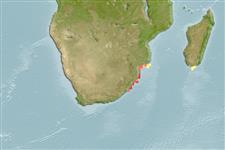Environment: milieu / climate zone / depth range / distribution range
ນິເວດວິທະຍາ
ສັດທະເລ ກ່ຽວກັນຫີນ; ລະດັບຄວາມເລິກ 20 - 50 m (Ref. 4319). Subtropical; 25°S - 33°S, 30°E - 46°E (Ref. 5222)
Western Indian Ocean: known only from Madagascar, Natal in South Africa, and southern Mozambique.
ຂະໜາດ / ນ້ຳໜັກ / Age
Maturity: Lm ? range ? - ? cm
Max length : 100.0 cm TL ຕົວຜູ້/ບໍ່ມີເພດ; (Ref. 4319); ນ້ຳໜັກສູງສຸດທີ່ເຄຍຈັດພີມມາ: 10.0 kg (Ref. 4319)
ຄີ (ໜາມ)ແຂງຢູ່ຫຼັງປາ (ທັງໝົດ) : 11; ຄີຫຼັງຂອງປາ (ຄີອ່ອນ) (ທັງໝົດ) : 15 - 16; ຄີ(ໜາມ) ແຂງຢູ່ຄີກົ້ນປາ
ກຸ່ມປາກະດູກແຂງ
ຄວາມຖີ່ຂອງກຸ່ມຖ່າຍທອດພັນ
ປາທີ່ມີການເຄື່ອນຍ້າຍຈາກທະເລໄປຫານ້ຳຈືດ ແລະນ້ຳຈືດຫາທະເລ
ປາທີ່ມີການເຄື່ອນຍ້າຍຈາກທະເລແລະໄປໄຂ່ຢູ່ນ້ຳຈືດ
ຄີກົ້ນຂອງປາ
ສັດທີ່ມີກະດູກສັນຫັຼງ
ການຖ່າຍທອດທາງກຳມະພັນຈາກພໍ່ແມ່ຫາລູກ: 3; ຄີກົ້ນຂອງປາ: 9. Distinguished by the following characteristics: body color dark reddish brown; head and body covered with small, irregular, close-set, dark red or reddish brown spots, pale interspaces forming irregular pale network pattern; 4 narrow, irregular, oblique, pale bars running down and forward on body; paired fins generally darker than body; body depth contained 3.1-3.5 times in SL; body width 1.7-2.0 times in depth; head length 2.3-2.4 times in SL; interorbital width 5.9-6.8 times in HL; concave interorbital area; rounded preopercle, finely serrate, shallow indentation just above angle; upper edge of operculum almost straight; inconspicuous opercular spines; posterior and anterior nostrils subequal; maxilla not reaching past eye; front of upper jaw with a pair of large, curved, fixed canines and a pair of similar but slightly smaller canines at front of lower jaw; lateral part of lower jaws with an outer row of 8-9 slightly smaller fixed canines and an inner row of smaller , more slender depressible teeth (Ref. 89707).
Appears to be a rare species, but it is of some importance to South African sport fishers along the northern coast of Natal. Coral reef-associated species inhabiting depths of 20-50 m (Ref. 89707). Feeds on fishes and invertebrates (Ref. 89707). Testes of a 61 cm SL specimen contained a central lumen and numerous 'brown bodies' along the lateral edges of the gonadal lamellae.
Life cycle and mating behavior
ການຈະເລີນເຕັມໄວ | ການສືບພັນ | ການວາງໄຂ່ | ໄຂ່ | ຄວາມດົກຂອງໄຂ່ປາ | ຕົວອ່ອນ
Heemstra, P.C. and J.E. Randall, 1993. FAO Species Catalogue. Vol. 16. Groupers of the world (family Serranidae, subfamily Epinephelinae). An annotated and illustrated catalogue of the grouper, rockcod, hind, coral grouper and lyretail species known to date. Rome: FAO. FAO Fish. Synop. 125(16):382 p. (Ref. 5222)
IUCN Red List Status (Ref. 130435: Version 2024-1)
Threat to humans
Harmless
Human uses
ການປະມົງ: ການປະມົງແບບກຸ້ມຕົນເອງ; ຊະນິດປາທີ່ຖືກນຳໃຊ້ເຂົ້າໃນການຫາເພື່ອເປັນເກມກິລາ: ແມ່ນ
ເຄື່ອງມື
Special reports
Download XML
ແຫຼ່ງອີນເຕີເນັດ
Estimates based on models
Preferred temperature (Ref.
123201): 23.7 - 24.7, mean 24.2 °C (based on 4 cells).
Phylogenetic diversity index (Ref.
82804): PD
50 = 0.5000 [Uniqueness, from 0.5 = low to 2.0 = high].
Bayesian length-weight: a=0.01175 (0.00568 - 0.02430), b=3.04 (2.88 - 3.20), in cm total length, based on LWR estimates for this Genus-body shape (Ref.
93245).
ຊັ້ນເຂດຮ້ອນ (Ref.
69278): 4.0 ±0.6 se; based on size and trophs of closest relatives
ຄວາມຢືດຢຸ່ນ (Ref.
120179): ຕຳ່ຫຼາຍ, ປະຊາກອນຕຳ່ສຸດທີ່ໃຊ້ເວລາສອງເທົ່າຫຼາຍກວ່າ 14 ປີ (Preliminary K or Fecundity.).
Fishing Vulnerability (Ref.
59153): High vulnerability (60 of 100).
